spare wheel Peugeot 508 2011 Owner's Manual - RHD (UK, Australia)
[x] Cancel search | Manufacturer: PEUGEOT, Model Year: 2011, Model line: 508, Model: Peugeot 508 2011Pages: 340, PDF Size: 25.76 MB
Page 76 of 340
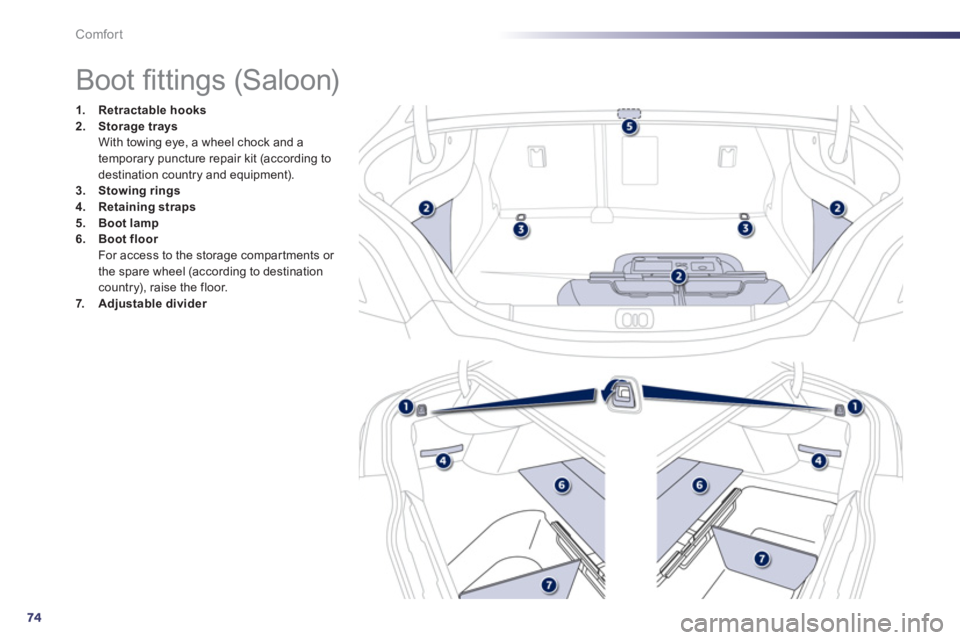
74
Comfort
Boot fi ttings (Saloon)
1.
Retractable hooks
2.
Storage trays
With towing eye, a wheel chock and a
temporary puncture repair kit (according to
destination country and equipment).
3.
Stowing rings
4.
Retaining straps
5.
Boot lamp
6.
Boot floor
For access to the storage compar tments or
the spare wheel (according to destination
country), raise the floor .
7.
Adjustable divider
Page 77 of 340
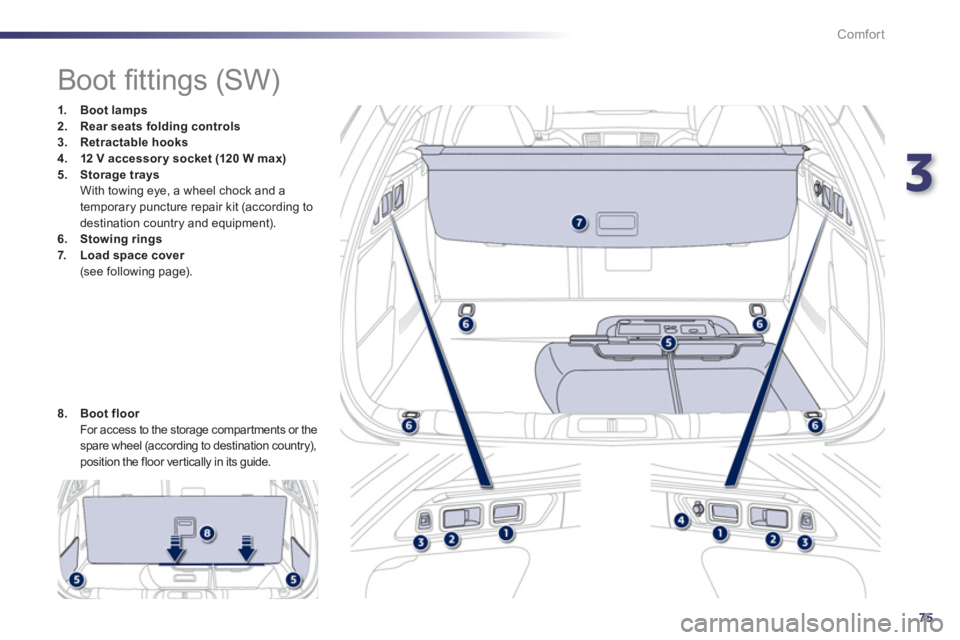
3
75
Comfort
Boot fi ttings (SW)
1.
Boot lamps
2.
Rear seats folding controls
3.
Retractable hooks
4.
12 V accessor y socket (120 W max)
5.
Storage
trays
With towing eye, a wheel chock and a
temporary puncture repair kit (according to
destination country and equipment).
6.
Stowing rings
7.
Load space cover
(see following page) .
8.
Boot floor
For access to the storage compar tments or the
spare wheel (according to destination country),
position the floor ver tically in its guide.
Page 161 of 340
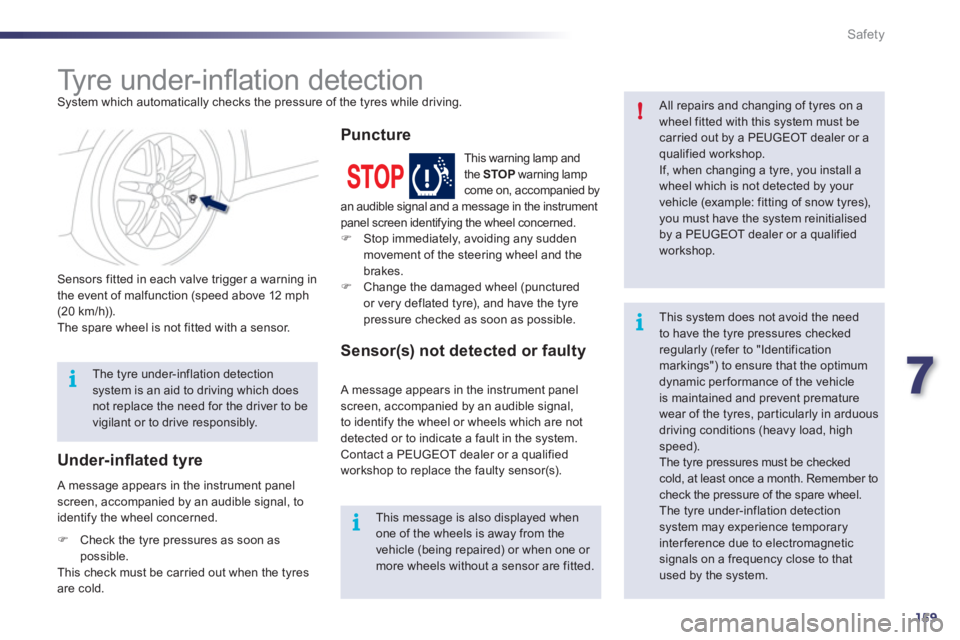
7
159
i!
i
i
Safety
Ty r e u n d e r - i nfl ation detection
System which automatically checks the pressure of the tyres while driving.
Sensors fitted in each valve trigger a warning in
the event of malfunction (speed above 12 mph
(20 km/h)).
The spare wheel is not fitted with a sensor.
All repairs and changing of tyres on a
wheel fitted with this system must be
carried out by a PEUGEOT dealer or a
qualified workshop.
If, when changing a tyre, you install a
wheel which is not detected by your
vehicle (example: fitting of snow tyres),
you must have the system reinitialised
by a PEUGEOT dealer or a qualified
workshop.
This message is also displayed when
one of the wheels is away from the
vehicle (being repaired) or when one or
more wheels without a sensor are fitted.
The tyre under-inflation detection
system is an aid to driving which does
not replace the need for the driver to be
vigilant or to drive responsibly.
This system does not avoid the need
to have the tyre pressures checked
regularly (refer to "Identification
markings") to ensure that the optimum
dynamic per formance of the vehicle
is maintained and prevent premature
wear of the tyres, particularly in arduous
driving conditions (heavy load, high
speed).
The tyre pressures must be checked
cold, at least once a month. Remember to
check the pressure of the spare wheel.
The tyre under-inflation detection
system may experience temporary
inter ference due to electromagnetic
signals on a frequency close to that
used by the system.
A message appears in the instrument panel
screen, accompanied by an audible signal, to
identify the wheel concerned.
Under-infl ated tyre
This warning lamp and
the STOP
warning lamp
come on, accompanied by
an audible signal and a message in the instrument
panel screen identifying the wheel concerned.
�)
Stop immediately, avoiding any sudden
movement of the steering wheel and the
brakes.
�)
Change the damaged wheel (punctured
or very deflated tyre), and have the tyre
pressure checked as soon as possible.
Puncture
A message appears in the instrument panel
screen, accompanied by an audible signal,
to identify the wheel or wheels which are not
detected or to indicate a fault in the system.
Contact a PEUGEOT dealer or a qualified
workshop to replace the faulty sensor(s).
Sensor(s) not detected or faulty
�)
Check the tyre pressures as soon as
possible.
This check must be carried out when the tyres
are cold.
Page 178 of 340
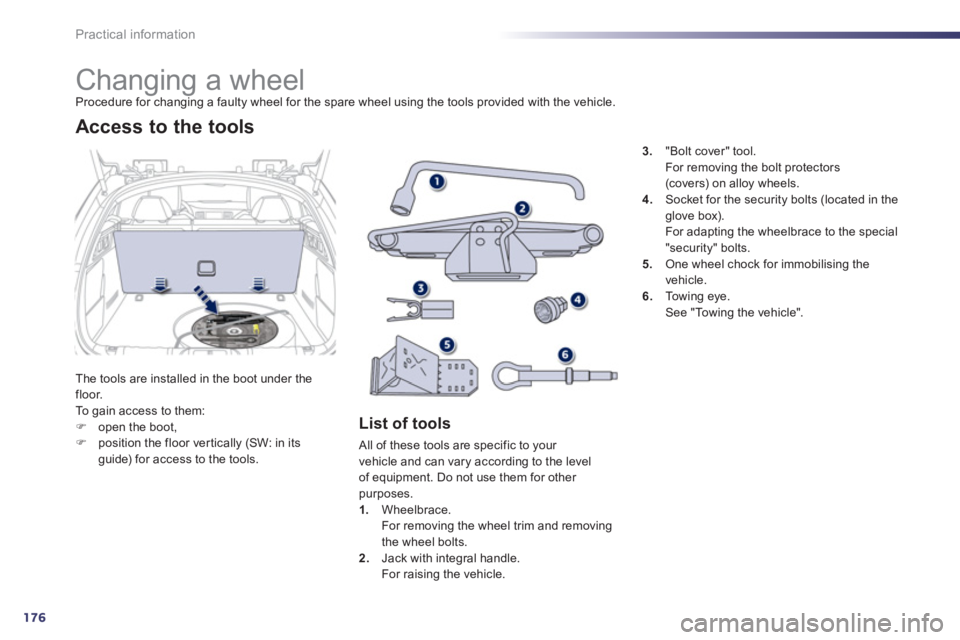
176
Practical information
Changing a wheel
Procedure for changing a faulty wheel for the spare wheel using the tools provided with the vehicle.
The tools are installed in the boot under the
floor.
To gain access to them:
�)
open the boot,
�)
position the floor ver tically (SW: in its
guide) for access to the tools.
Access to the tools
List of tools
All of these tools are specific to your
vehicle and can vary according to the level
of equipment. Do not use them for other
purposes.
1.
Wheelbrace.
For removing the wheel trim and removing
the wheel bolts.
2.
Jack with integral handle.
For raising the vehicle.
3.
"Bolt cover" tool.
For removing the bolt protectors
(covers) on alloy wheels.
4.
Socket for the security bolts (located in the
glove box).
For adapting the wheelbrace to the special
"security" bolts.
5.
One wheel chock for immobilising the
vehicle.
6.
To w i n g e y e .
See "Towing the vehicle".
Page 179 of 340
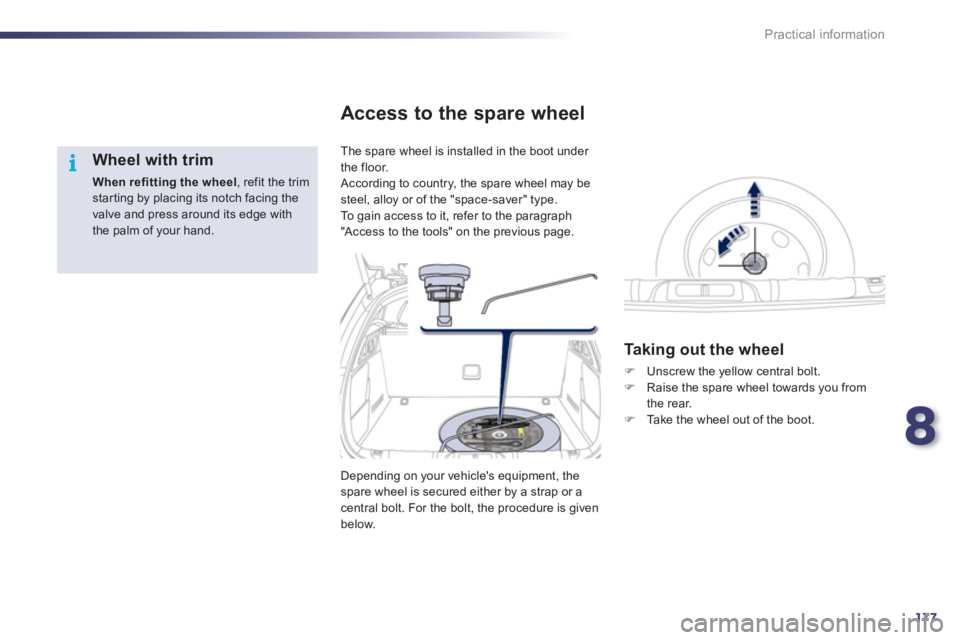
8
177
i
Practical information
Wheel with trim
When refitting the wheel
, refit the trim
star ting by placing its notch facing the
valve and press around its edge with
the palm of your hand.
The spare wheel is installed in the boot under
the floor.
According to country, the spare wheel may be
steel, alloy or of the "space-saver" type.
To gain access to it, refer to the paragraph
"Access to the tools" on the previous page.
Access to the spare wheel
Taking out the wheel
�)
Unscrew the yellow central bolt.
�)
Raise the spare wheel towards you from
the rear.
�)
Take the wheel out of the boot.
Depending on your vehicle's equipment, the
spare wheel is secured either by a strap or a
central bolt. For the bolt, the procedure is given
below.
Page 180 of 340
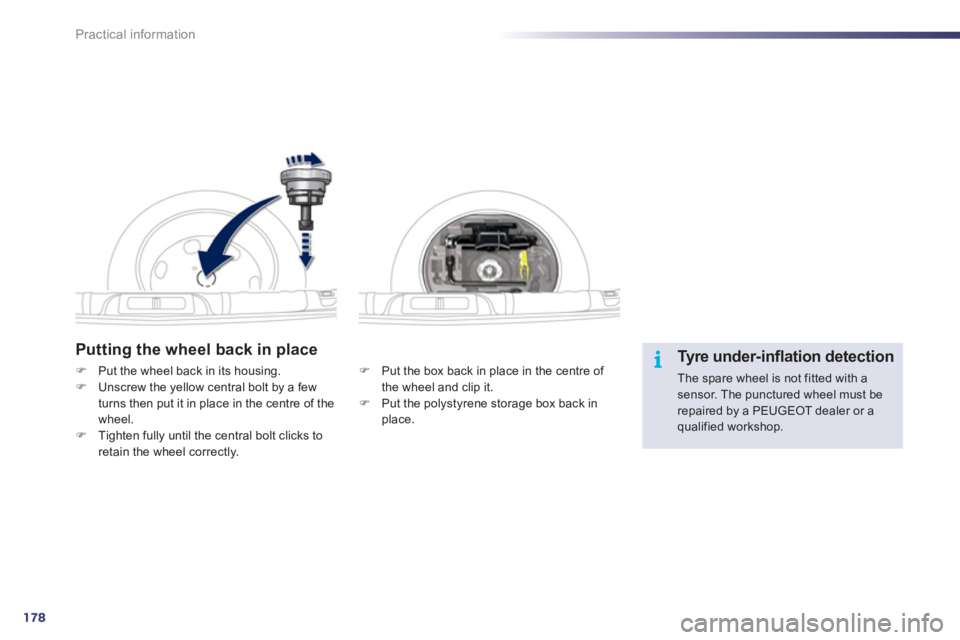
178
i
Practical information
Putting the wheel back in place
�)
Put the box back in place in the centre of
the wheel and clip it.
�)
Put the polystyrene storage box back in
place.
�)
Put the wheel back in its housing.
�)
Unscrew the yellow central bolt by a few
turns then put it in place in the centre of the
wheel.
�)
Tighten fully until the central bolt clicks to
retain the wheel correctly.
Ty r e u n d e r - i nfl ation detection
The spare wheel is not fitted with a
sensor. The punctured wheel must be
repaired by a PEUGEOT dealer or a
qualified workshop.
Page 182 of 340
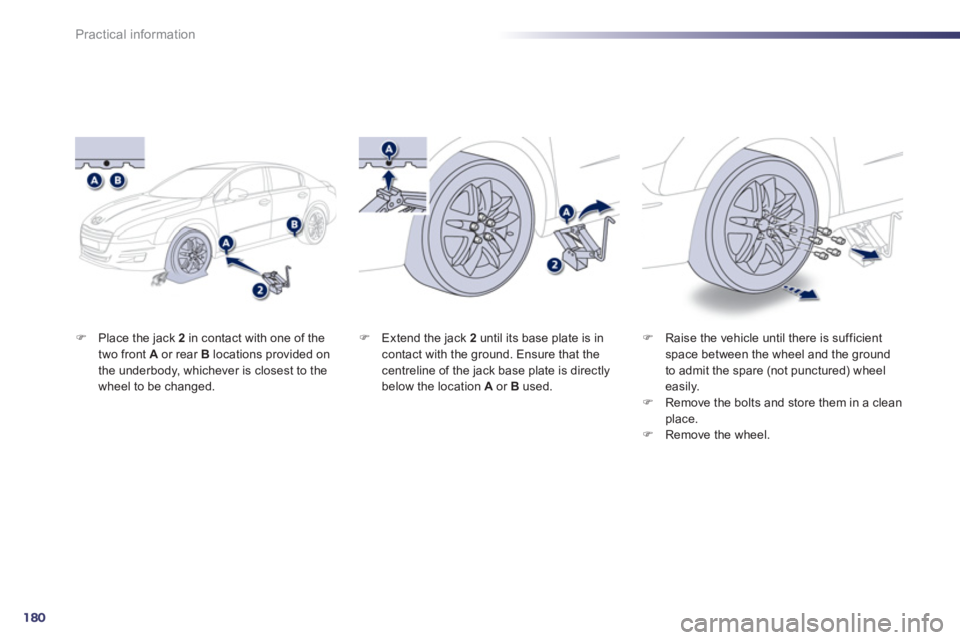
180
Practical information
�)
Place the jack 2
in contact with one of the
two front A
or rear B
locations provided on
the underbody, whichever is closest to the
wheel to be changed.
�)
Raise the vehicle until there is sufficient
space between the wheel and the ground
to admit the spare (not punctured) wheel
easily.
�)
Remove the bolts and store them in a clean
place.
�)
Remove the wheel.
�)
Extend the jack 2
until its base plate is in
contact with the ground. Ensure that the
centreline of the jack base plate is directly
below the location A
or B
used.
Page 183 of 340
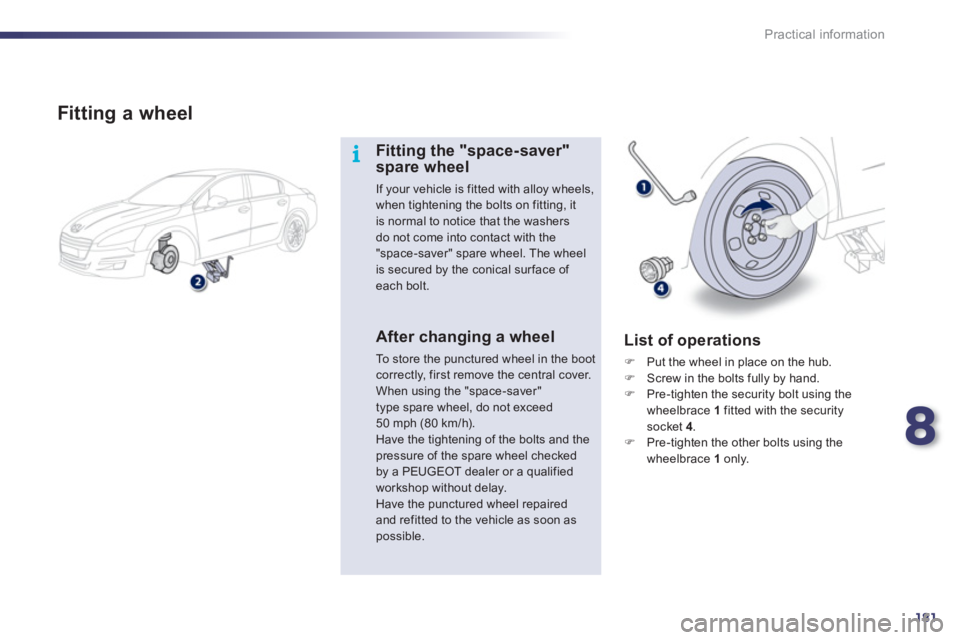
8
181
i
Practical information
Fitting a wheel
Fitting the "space-saver"
spare wheel
If your vehicle is fitted with alloy wheels,
when tightening the bolts on fitting, it
is normal to notice that the washers
do not come into contact with the
"space-saver" spare wheel. The wheel
is secured by the conical sur face of
each bolt.
After changing a wheel
To store the punctured wheel in the boot
correctly, first remove the central cover.
When using the "space-saver"
type spare wheel, do not exceed
50 mph (80 km/h).
Have the tightening of the bolts and the
pressure of the spare wheel checked
by a PEUGEOT dealer or a qualified
workshop without delay.
Have the punctured wheel repaired
and refitted to the vehicle as soon as
possible.
List of operations
�)
Put the wheel in place on the hub.
�)
Screw in the bolts fully by hand.
�)
Pre-tighten the security bolt using the
wheelbrace 1
fitted with the security
socket 4
.
�)
Pre-tighten the other bolts using the
wheelbrace 1
only.
Page 230 of 340
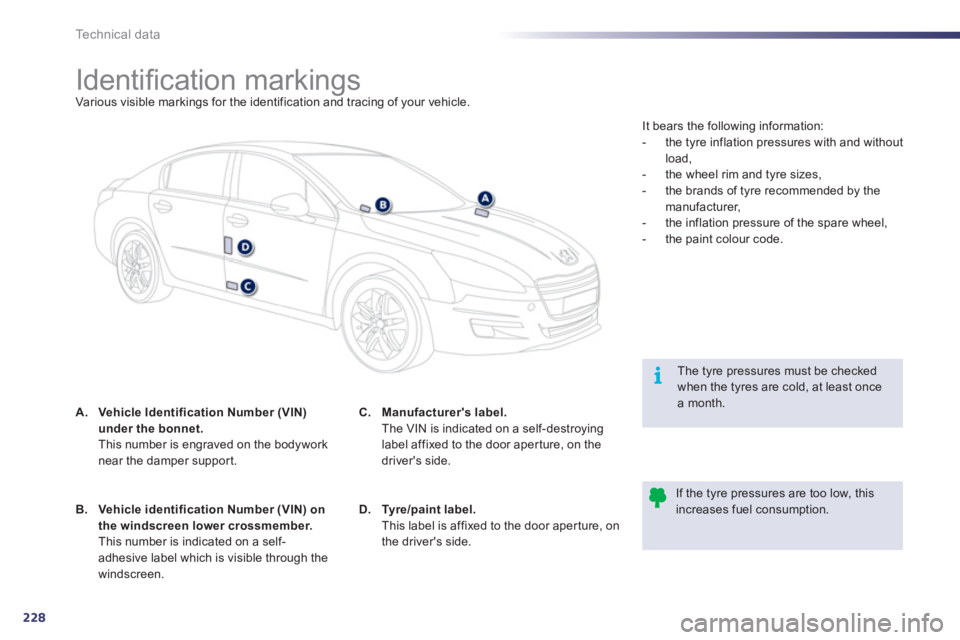
228
i
Technical data
Identifi cation markings
Various visible markings for the identification and tracing of your vehicle.
A.
Vehicle Identification Number (VIN)
under the bonnet.
This number is engraved on the bodywork
near the damper suppor t.
The tyre pressures must be checked
when the tyres are cold, at least once
a month.
If the tyre pressures are too low, this
increases fuel consumption.
B.
Vehicle identification Number (VIN) on
the windscreen lower crossmember.
This number is indicated on a self-
adhesive label which is visible through the
windscreen.
C.
Manufacturer's label.
The VIN is indicated on a self-destroying
label affixed to the door aper ture, on the
driver's side.
D.
Ty r e / p a i n t l a b e l .
This label is affixed to the door aper ture, on
the driver's side. It bears the following information:
- the tyre inflation pressures with and without
load,
- the wheel rim and tyre sizes,
- the brands of tyre recommended by the
manufacturer,
- the inflation pressure of the spare wheel,
- the paint colour code.
Page 324 of 340
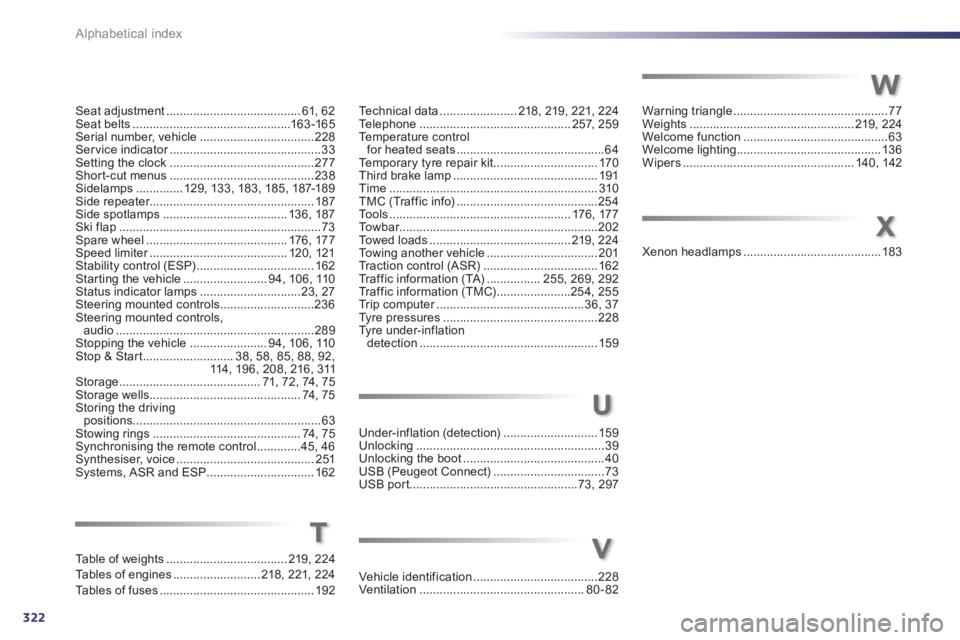
322Alphabetical index
Seat adjustment ........................................ 61, 62
Seat belts ...............................................163 -165
Serial number, vehicle ..................................228
Ser vice indicator .............................................33
Setting the clock ...........................................277
Shor t-cut menus ...........................................238
Sidelamps .............. 129, 133, 183, 185, 187-189
Side repeater................................................. 187
Side spotlamps ..................................... 136, 187
Ski flap ............................................................ 73
Spare wheel .......................................... 176, 177
Speed limiter ......................................... 120, 121
Stability control (ESP) ................................... 162
Star ting the vehicle ......................... 94, 106, 110
Status indicator lamps ..............................23, 27
Steering mounted controls ............................236
Steering mounted controls,
audio ...........................................................289
Stopping the vehicle ....................... 94, 106, 110
Stop & Star t ........................... 38, 58, 85, 88, 92,
114, 196, 208, 216, 311
Storage .......................................... 71, 72, 74, 75
Storage wells............................................. 74, 75
Storing the driving
positions........................................................ 63
Stowing rings ............................................ 74, 75
Synchronising the remote control .............45, 46
Synthesiser, voice ......................................... 251
Systems, ASR and ESP ................................ 162
Table of weights .................................... 219, 224
Tables of engines .......................... 218, 221, 224
Tables of fuses .............................................. 192Technical data ....................... 218, 219, 221, 224
Telephone ............................................. 257, 259
Temperature control
for heated seats ............................................64
Temporary tyre repair kit ............................... 170
Third brake lamp ........................................... 191
Time .............................................................. 310
TMC (Traffic info) ..........................................254
Tools ...................................................... 176, 177
To w b a r ...........................................................202
Towed loads .......................................... 219, 224
Towing another vehicle ................................. 201
Traction control (ASR) .................................. 162
Traffic information (TA) ................ 255, 269, 292
Traffic information (TMC) ......................254, 255
Trip computer ............................................36, 37
Tyre pressures ..............................................228
Tyre under-inflation
detection ..................................................... 159
Under-inflation (detection) ............................ 159
Unlocking ........................................................39
Unlocking the boot .......................................... 40
USB (Peugeot Connect) ................................. 73
USB port..................................................73, 297
U
T
Warning triangle .............................................. 77
Weights ................................................. 219, 224
Welcome function ........................................... 63
Welcome lighting ........................................... 136
Wipers ................................................... 140, 142
W
Xenon headlamps ......................................... 183
X
Vehicle identification .....................................228
Ventilation ................................................. 80 - 82
V